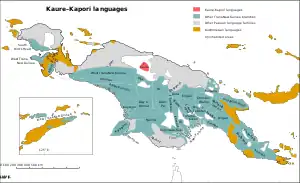Kaure–Kosare languages
The Kaure–Kosare or Nawa River languages are a small family spoken along the Nawa River in West Papua, near the northern border with Papua New Guinea.[1] The languages are Kaure and Kosare.
| Kaure–Kosare | |
|---|---|
| Nawa River | |
| Geographic distribution | Nawa River, New Guinea |
| Linguistic classification | a primary language family |
| Subdivisions | |
| Glottolog | None |
 Map: The Kaure–Kapori languages of New Guinea
The Kaure–Kapori languages
Trans–New Guinea languages
Other Papuan languages
Austronesian languages
Uninhabited | |
Classification
Kaure and Kosare (Kosadle) are clearly related. There is a history of classifying them with the Kapori–Sause languages. However, Kapori and Sause show no particular connection to the Kaure languages, and may be closer to Kwerba.[1]
Foley (2018) considers a connection with Trans-New Guinea to be promising, but tentatively leaves Kaure-Kosare out as an independent language family pending further evidence.[2]
Proto-language
Phonemes
Usher (2020) reconstructs the consonant inventory as follows:[1]
*m *n *p *t *k *b *g *s *h *w *ɽ [*j]
Coda consonants are stop *C (or more precisely *P) and nasal *N.
*i *u *e *o *ɛ *ɔ *æ *a
Diphthongs are *ɛi, *ɛu, *ai *au.
Basic vocabulary
Some lexical reconstructions by Usher (2020) are:[1]
gloss Proto-Nawa River hair *haⁱ ear *hwɔkɽuC eye *hwe̝N tusk/tooth *pakaⁱ skin/bark *ki breast *muN louse *miN dog *se̝ pig *pî bird *ho̝C tree *tɛⁱC woman *naⁱ sun *h[æ/a]niC moon *paka water *mi[jɛ] fire *sa(-[n/ɽ]ɛN) eat *naⁱ
Vocabulary comparison
The following basic vocabulary words are from Voorhoeve (1971, 1975)[3][4] and other sources, as cited in the Trans-New Guinea database:[5]
gloss Kaure[6] Kosare[7] Narau head kasera; pleŋ; pɔklai potɔ´ hair hai; hat potɔi fukura hai ear goklu; huaglüt 'kɔro eye gewe; hwai; hwew ĩsɛrit nose gopo; hapu moro 'kakò tooth sbeje; səbokai pɛki sebekai tongue sremu; sɾumu pɛrɛ´ leg due; duɛ nue louse mi; mĩ mi dog se sé pig pi pi kandu bird hou; hu; ku o egg hore; te; wale ho's̪ɛri blood hi; katesa; katsa ña bone era; laq; loa 'kákò skin aguli; arohei; axlit breast mu; muq kó kakò tree te; tei; teija tĩⁿdi bimesini man debla; dido nepra woman dae ḑɩmɔ'kasia sky lɛbü nubɷ sun hafei; haɾi; harei ɛnɛ´ⸯ kaberja moon gaka; poka paka water bi; biq; gomesi biɛ bi fire sa; saʔ; sareŋ sá sare stone təsi; tɛsi; tisi 'naka road, path selu kɛmɔrɔ´ name bəre; blɛ; nokomne morɔ eat ganasi; kadi; kandɛ kɛnɛ´ kanaisini one gogotia; kauxjaʔ; kaxotia kora'ɸɛ two tɾapli; təravərei; trapi tau
See also
References
- New Guinea World, Nawa River
- Foley, William A. (2018). "The languages of Northwest New Guinea". In Palmer, Bill (ed.). The Languages and Linguistics of the New Guinea Area: A Comprehensive Guide. The World of Linguistics. 4. Berlin: De Gruyter Mouton. pp. 433–568. ISBN 978-3-11-028642-7.
- Voorhoeve, C.L. "Miscellaneous Notes on Languages in West Irian, New Guinea". In Dutton, T., Voorhoeve, C. and Wurm, S.A. editors, Papers in New Guinea Linguistics No. 14. A-28:47-114. Pacific Linguistics, The Australian National University, 1971. doi:10.15144/PL-A28.47
- Voorhoeve, C.L. Languages of Irian Jaya: Checklist. Preliminary classification, language maps, wordlists. B-31, iv + 133 pages. Pacific Linguistics, The Australian National University, 1975. doi:10.15144/PL-B31
- Greenhill, Simon (2016). "TransNewGuinea.org - database of the languages of New Guinea". Retrieved 2020-11-05.
- Clouse, D.A. 1997. Towards a reconstruction and reclassification of the Lakes Plain languages of Irian Jaya. In Franklin, K. (ed). Papers in Papuan Linguistics No. 2. Pacific Linguistics: Canberra.
- Heeschen, V. 1978. The Mek languages of Irian Jaya with special reference to the Eipo language. Irian, 2: 3-67.
- Ross, Malcolm (2005). "Pronouns as a preliminary diagnostic for grouping Papuan languages". In Andrew Pawley; Robert Attenborough; Robin Hide; Jack Golson (eds.). Papuan pasts: cultural, linguistic and biological histories of Papuan-speaking peoples. Canberra: Pacific Linguistics. pp. 15–66. ISBN 0858835622. OCLC 67292782.
External links
- Kaure languages database at TransNewGuinea.org
- Timothy Usher, New Guinea World, Proto–Nawa River